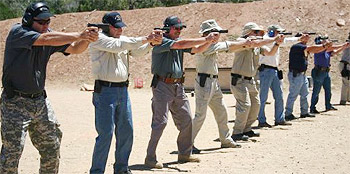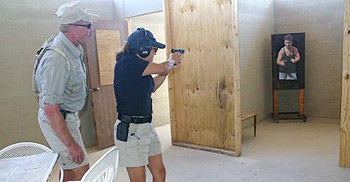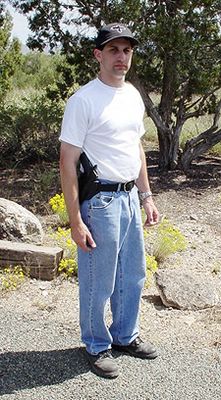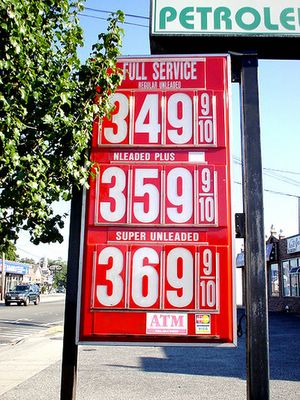
Gunsite Academy entrance at sunset
Last year I was inspired to start this web log by a trip to Arizona. During that trip I attended a pistol combat school called Gunsite and felt the need to record my experience. I had so much fun out there and learned so much, that I returned this year for the next course in the Defensive Pistol series - number 350. This time around, my father and I took the class together. He had completed the 250 course a few years ago, so we were able to attend the 350 together (having both completed the prerequisite 250 course). It was a lot of fun taking the course with him.
The 350 course was a different from the 250. It was a lot faster because the instructors were building on things we had learned in the 250 course. There were fewer lectures. Sure... we still got the standard safety lecture and a bit of a refresher on the 250 techniques, but then we were off and running. All of the students were very safe and handled their firearms well. It really showed that we had all had one course under our belt already. People "got it" very quickly when the instructors showed us something new. The smaller class size, 15 students this time around, also helped the instructors cover topics more quickly. There was no need to split the class into two "relays" like we did in my 250 (with 25 students). The square ranges have 16 stations, so we were covered with one to spare. There wasn't much downtime, but we did take a lot of breaks to "hydrate and urinate." After all, the average temperature for the week was 85° F during that week in September. Far different from the near freezing temperatures I had to endure last December during the 250.

Gunsite students on the firing line
Our instructors were Dean Caputo (course range master), Lamonte Kintsel, and Chris Weare... all three were great guys. These men posses a wealth of knowledge and experience. What's so great is that they never make you feel like you are beneath them. The instructors are excited about passing on their skills to students and are very encouraging and patient. They want you to do well and have fun while you learn. They correct the students in a manner that is very sensitive to the natural anxieties we all feel when we are students trying to learn in a performance driven course. They really do create a great learning environment.
The students were from varied backgrounds, but there were a lot of "professionals" in the class. We had police officers, a Sheriff, a few National Guardsmen - the rest were firearm enthusiasts like me and my father. No women in the class this time though... bummer. The students brought mostly 1911 variants like I did, some Beretta 92FS's and I did see a Springfield XD, a Heckler and Koch P7, and a couple of Glocks. Several people had issues with their pistols. I did have a few jams... two from limp wristing that were totally the fault of my bad form and one from a wobbly magazine follower that failed to feed a round properly. On the whole, my Kimber TLE II ran great for nearly all the 900+ rounds I fired. I'd still bet my life on it... the pistol itself is fine. At the end of class one night, we found that my Dad's slide stop had broken, but not in any way that impaired the gun's ability to fire. A trip to the 'smith in the morning for a replacement part and the thing was good as new.
My Dad and I got to do some cool things while we were there - very cool for us since the ranges out here in NY where we usually practice are very restrictive. When the instructor announced that we would be drawing and shooting "on the move", I had a big grin on my face. Always wanted to do that. We walked forward and backward while shooting. The important thing there was to do a heel-toe type of walk so your body wouldn't bounce around to much and jostle your gun. Once we had the walk down, each of us had a turn walking across the range perpendicular to targets facing our left or right side (we tried both ways). The instructor called out which ones to shoot. We then had to pivot our torso and fire without changing direction or stopping. We also did a diagonal walk, walking progressively closer to or further away from the targets we were prompted to shoot. Again, we tried this twice with targets to our left then right sides. Then there was the close quarters firing from there retention position. Here, your pistol hand forearm is against your ribs and your wrist is rotated at a slight angle (so your body does not get battered by the slide during its rearward travel). Your non-firing hand is placed palm against the back of your head and your elbow protrudes forward to help fend off the attacker.
There was another exercise during the week where we fired on 4 separate targets, each marked with a different number and placed at different heights and distances from the student. The instructor called out a number and you fired on the randomly chosen target. Simple... right? Then there were the moving targets that passed by you from left to right. Those were fun. We did the familiar El Presidente drill and the Donga drills as well during the week.
We learned how to fire from behind cover while making ourselves less of a target to our imaginary enemy. The targets were about 75ft away and steel, so you could hear if you hit or missed. We each ran through three different cover options and tried a few different stances and positions at each. I tried shooting a pistol from the prone position during this lesson (and earlier in the week), but wasn't really comfortable with it. It seems they dropped that position from the 250 when I took it so it was new to me. While it is a very stable position, I was having trouble getting into it and firing with my hearing protection in the way. The earmuffs I wear have huge cups that cover your ears and I had difficulty leaning my head against my arm to get a sight picture. It was still fun to try something I had never done before.
Another thing I'd never tried was gun handling with a single hand... and my left hand at that! I am right handed so my left is my weak hand. We learned how to get the pistol out of our holsters on our right side with our weak hand, bring it up on target, release the safety and fire. We learned how to change mags and rack the slide on our leg or belt in order to clear jams or load. It was fun, but I was a little nervous using the "wrong" hand. Even though I have some dexterity in my left fingers from playing guitar, my left hand is pretty awkward when used for anything else. Trigger finger management was a problem for some. Even though you are using your weak hand, you still have to keep your finger out of the trigger guard until you are on target and ready to fire.
We ran a bunch of simulators during this course. The indoor simulators were more of a challenge to navigate than in the 250. One instructor said he "saw my gears turning" at certain points when I was trying to decide on the best way to approach certain doorways and hallway intersections. Some of the choices were hard to make. The outdoor simulators were cool too. We were instructed on how to navigate the rocky terrain of a wash without tripping. We were also coached to avoid the tendency to crouch while searching for targets outdoors... it limits your line of sight and makes for labored breathing.

A student from another class running an indoor simulator
Night simulators were a part of this course too. We had a lecture on the different types of tactical flashlights available and a run through of the techniques for using the lights in concert with a firearm. We did a little work on the range and then moved on to the simulators. Night simulators are a whole different ball game! In the house, your flashlight casts shadows that play tricks on your eyes. Glaring of the beam off the walls screws up your night vision. Working the light and the gun while opening doors and trying to reload is a bit tricky. The outdoor night simulator gave me a new respect for cops that have to chase after or search for someone at night... especially in country areas like the Gunsite grounds. When that flashlight is off, you see nothing! When it's on, anyone can see you from a mile away! The searcher is definitely at a disadvantage.
The culmination of the simulator training was the force-on-force training where you get to interact with a real person acting as a threat. We used special pistols that fired a soap/paint pellet. The weapons that fired them were replicas actual pistols so you could use a Glock or a 1911 or a Sig, etc. The weapons function the same way. I won't spoil the simulation and tell you exactly what happened, but when it came time that I decided I need to pop the bad dude, my pistol jammed. I performed a tap-rack malfunction clearance and managed to snag the protective glove I was wearing in the slide. Eventually I shot the guy, but I guess the hits weren’t good enough because he charged me. I shot him two more times while he came at me, blue paint splattered across his chest and the instructor ended the scenario. During my debrief, they told me that during the whole thing, I planted my feet and never moved. I never tried to seek cover while a 6 foot tall guy decided to charge me even though he was staring down the barrel of a (paintball) gun. Better to make mistakes in a simulator though. The number one lesson: "Distance is your Friend."

Force on force simulator
We did the student shoot-off at the end, a Gunsite tradition. It took a long time as we were very evenly matched in skill. Nobody consistently outshined anyone else. We all won and lost at the same rate it seemed. The old adage proved true... "He who wins the (gun)fight is he who made the least mistakes." The slight bit of pressure caused by friendly competition is enough to throw you off. Imagine if you were fighting for your life. All the more reason to stay aware and stay out of a deadly situation. The best way to win a fight is to not take part in it. If someone brings the fight to you, you'd better be the one to make less mistakes during the encounter.

Me at Gunsite
